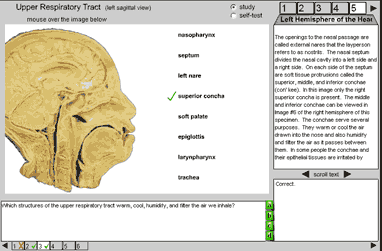When one door closes, another opens.
In 1999, Bob Neeves reached
the end of a grant project that brought anatomy and physiology to middle
and high school students in the Christina (DE) School District. Based
on its success, he decided to rework the project for his University
of Delaware students.
"Originally
we implemented the use of plastinated human cardiovascular and pulmonary
specimens in Christina School District health classes. When the grant
was no longer available, we used the plastinated specimens in two classes
at the University of Delaware to offset the need for actual human cadaver
specimens," says Bob Neeves, professor.
Based on
positive student reactions to real human organs and the fact that their
responses indicated a better understanding of cardiopulmonary principles
and pathologies, Neeves used the project as the springboard for revamping
his entire course. With input from the Center for Teaching Effectiveness
and the PRESENT, Neeves moved away from traditional lectures and toward
problem-based learning exercises, case studies and online presentations.
To get started, Neeves consulted the staff of the PRESENT for help
putting material online. As a result, Neeves' PowerPoint slides became
the basis of a program—UD's Slide Show Plus—for enhancing
slides for the web.
Using the program and with
the help of PRESENT staff member Becky Kinney, Neeves added interactivity
to his PowerPoint presentations on the web in a way that includes detailed
information and some self-test questions.
"Any PowerPoint slide show or sequence of static images can be
enhanced with text, questions and labels using the existing templates,"
says Kinney. "The hardest part of adopting this format, from the
faculty perspective, is writing the text and questions to accompany
each slide."
The program
provides a way for students to view images of human anatomy and review
concepts through related quiz questions. Neeves and Kinney added interactive
labeling to the presentation so that students could easily identify
different portions of the heart and lungs.

Through plastination—a
process that replaces water in biological tissue with liquid
silicone,
making an organ safe for classroom use—Neeves can provide students
with human organs for learning. Slide Show Plus provides Neeves'
students an opportunity for more time to learn the intricacies
of human anatomy.
"Student response to the interactive web page images, text, and
self-graded quizzes have been favorable. They would like to see more
images, different views, more quiz questions, and outside web sites
to expand their study resources," says Neeves.
What started
as a project for the local middle and high school program became the
catalyst for transforming how Neeves' students experience anatomy and
physiology instruction.
